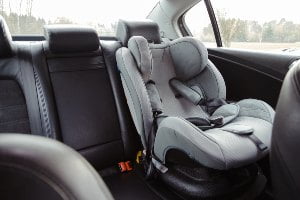
While no one is built to withstand the trauma of a car accident, children are especially vulnerable. That is why it is so important for children to be properly restrained in the appropriate type of car seat. Parents and caregivers also need to make sure to install the seat correctly so it can provide the protection the child needs.
It is Child Passenger Safety Week and Galloway Jefcoat wants you and your children to be safe on the road. That is why we have created a guide to Louisiana’s car seat laws.
Louisiana Laws On Restraining Child Passengers
Louisiana car seat laws are in line with federal guidelines on protecting child passengers from harm during a collision. These laws recognize that children need to be in different types of car seats based on their age, height and weight. Each type of car seat has specific benefits based on the child’s stage of development.
Louisiana car seat laws are as follows:
- From birth until two years of age children should be placed in a rear-facing seat that complies with relevant federal regulations. Two years of age is not a hard and fast cutoff point. However, children should remain in a rear-facing seat until they exceed the height and weight limit of that seat. Height and weight limits are set by the manufacturer.
- From two to four years of age children should be put in a forward-facing seat with an internal harness until they exceed the height and weight limit set by the manufacturer. This assumes the child has outgrown the rear-facing seat. If not, the child should remain in a rear-facing seat.
- From four years of age until nine years of age children should be placed in belt-positioning child booster seats. These seats are secured with the vehicle’s lap-shoulder belt. This assumes the child has outgrown the forward-facing seat.
- From nine years of age until about 13 the child should be placed in the back seat and restrained by the vehicle’s seat belt, assuming the belt fits properly. The child’s knees should bend over the edge of the seat and the belt should be snug on the thighs and lower hips and across the child’s chest. Seat belts do not fit properly if they rest on the child’s neck and/or abdomen.
- Children under the age of 13 should be placed in the back seat and restrained by the vehicle’s seat belt.
If you are unsure whether your child is in the appropriate car seat, there are several car seat fitting stations in Lafayette Parish. You can call to make an appointment to have your child’s seat inspected to ensure it is appropriate and has been installed correctly.
Penalties For Violating Child Passenger Restraint Laws
Failing to restrain a child in any type of child restraint system is a primary offense. That means the police can pull you over specifically for violating this section of the law. They do not need another reason to pull you over.
Failing to secure a child in the age or size-appropriate restraint is a secondary offense. That means the police cannot cite you for it unless they stop you for a moving violation.
If convicted of violating these laws, the first offense comes with a $100 fine. The second offense carries a fine of between $250 and $500 while a third offense carries a fine of $500 plus court costs.
How the Right Car Seat Reduces the Risk of Injury in a Crash
Different car seats have different benefits. For example, rear-facing seats cradle infants and toddlers, which helps to reduce stress on the neck and spinal cord. These body parts are especially fragile in young children. Properly-used rear-facing seats reduce the risk of fatal car crash injuries to infants by 71 percent, according to the National Highway Traffic Safety Administration.
Forward-facing seats have harnesses that limit forward movement in a collision. This helps reduce stress on the child’s body. Forward-facing and rear-facing seats reduce fatal injury risk in children between one and four years old by 54 percent.
Booster seats allow the vehicle’s seat belt to work as it is supposed to. The booster seat ensures the seat belt fits properly and restrains the child during and after impact.
When your child is old enough to use the seat belt without any type of booster seat, he or she should continue to ride in the back seat until the age of 13. The reason is that front seat airbags can cause serious injuries to young children.
Were You or Your Child Injured in a Crash? Call Galloway Jefcoat
If you or your child were injured in a crash caused by a negligent driver, we may be able to help you seek compensation for medical care and other damages. Our firm has been helping crash victims for decades, securing millions in compensation.
Our Lafayette auto accident lawyers represent Louisiana crash victims on contingency, which means no upfront costs or legal obligations.
Call us for legal assistance: 337-984-8020. We are here to help.